| Srl | Item |
| 1 |
ID:
157485
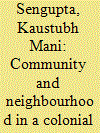

|
|
|
|
|
| Summary/Abstract |
This article on the history of neighbourhoods (para) of colonial Calcutta considers the processes through which this peculiar spatial unit emerged in the colonial city, where community identities were fostered as well as contested. Seen as a place, a secured, stable location which helped in forming the community in an alien atmosphere, the para was a liminal space, neither a purely affective unit nor an administrative category, and neither a purely public or private domain. Borrowing liberally from each register to generate a unique spatial experience, paras were at the same time deeply exclusionary and also starkly patriarchal zones. The article brings forth these various strands in the history of the neighbourhood to enrich the understanding of colonial urbanism, Bengali society and culture.
|
|
|
|
|
|
|
|
|
|
|
|
|
|
|
|
| 2 |
ID:
132795
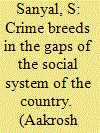

|
|
|
|
|
| Publication |
2014.
|
| Summary/Abstract |
A social system of a country is the baseline and the centre of growth and it acts as a mirror to the development of the nation and its people as a whole. When feelings of unrest, dissatisfaction and being ignored spread from one individual to more people in the same situation. they gradually transgress to bigger groups. having a ripple effect on a particular section of the society. Finally, they emerge into a larger unrest and turbulence, not only bringing in a divide between different regions, slates and communities, but also disrupting the total harmony of the country. Inequality is the main cause of this disharmony, and it can spiral-head from many sources. The simmering uneasiness, if not contained or controlled by the government. explodes into all forms of social turbulence. ranging from class and caste fight to communal riots and internal turbulence. fostering insurgency and a separatist attitude among the people in the country. Regional divide further promotes polarization of a particular section of the society, which then fights for a separate statehood. These are the consequences of an unequal distribution of growth wealth and prosperity. Thereafter, these gaps, differences and inequality are factors which contribute to social dysfuction and become a vital cause of crimes of any pattern
|
|
|
|
|
|
|
|
|
|
|
|
|
|
|
|
| 3 |
ID:
039999
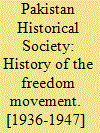

|
|
|
|
|
| Publication |
DelhI, Renaissance Publishing House, 1970.
|
| Description |
330p.Hbk
|
| Contents |
Vol. IV
|
|
|
|
|
|
|
|
|
|
|
|
Copies: C:1/I:0,R:0,Q:0
Circulation
| Accession# | Call# | Current Location | Status | Policy | Location |
| 024342 | 909.095403/PAK 024342 | Main | On Shelf | General | |
|
|
|
|
| 4 |
ID:
184939
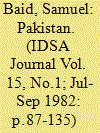

|
|
|
| 5 |
ID:
094015
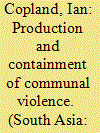

|
|
|
|
|
| Publication |
2010.
|
| Summary/Abstract |
Indian nationalists embraced the Partition of the subcontinent in 1947 in part because it appeared to offer a solution to the intractable 'communal problem' that had plagued the last three-quarters of a century of British rule; and at first the surgery of Partition seemed to make a difference. The incidence of overt 'communalism', in the shape of inter-ethnic collective violence between groups self-identified as 'Hindus' and 'Muslims', fell sharply after 1947 and remained low throughout the 1950s and early 1960s. But the remission did not last. Seventy-five significant communal incidents were recorded in 1955. The annual figure for 1965 was 173, for 1975 it was 205 and for 1985, 525.1 After a relative lull in the late 1980s, there was a further escalation in the last years of the twentieth century and in the first quinquennium of the twenty-first during which over 3,000 people were killed in the post-Ayodhya riots of 1992-93 and at least 1000 in the Gujarat pogrom of 2002. The level of communal violence in India today is greater, by a good margin, than it was in the late colonial era, and riots afflict far more of the country. No less than a quarter of India's 450 districts are now classified by the Home Ministry as 'hypersensitive'.
|
|
|
|
|
|
|
|
|
|
|
|
|
|
|
|